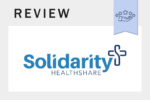This post may contain affiliate links, which means if you enroll through my link, I’ll receive a small commission at no extra cost to you.

In the United States, health insurance helps make medical procedures and treatments more affordable. However, in recent years, traditional health insurance has become more and more expensive. So, what are the best health insurance alternatives?
Alternatives to health insurance include paying medical expenses out of pocket, health discount cards, and catastrophic coverage. These plans are almost always cheaper than traditional health insurance but may have limited coverage. Be sure to understand what is and isn’t included in your program.
To learn more about health insurance alternatives, keep reading.
Health Share Plans
The first health insurance alternative you should consider is a Health Share Plan. They are non-profit organizations that help people pool their resources in order to share in medical costs.
Health Share plans are somewhat similar to traditional health insurance, as they include aspects like:
- A monthly membership fee. The monthly rates for Health Share programs are lower than the monthly rates for traditional health insurance.
- If you receive health care, you will have to pay part of the cost.
- The Health Share plan will cover about the same amount of medical costs as traditional health insurance.
- The program will contact doctors and caregivers in order to negotiate prices.
There are a variety of different places and programs that will let you do a cost-sharing health insurance program, but in many cases, these programs will have some stipulations that you have to follow. As many of these programs are run by faith-based organizations, the stipulations can include things such as not drinking alcohol to even staying a member of that faith as long as you are in the program. Of course, you can find other Health Share plans that do not have any religious affiliations that may be a better fit for your needs.
The cost of cost-sharing programs varies, but they are typically determined by how many of your family members are a part of the program. An example of this is that a young single person might only have to pay $1,000 each year, while larger families might have to pay up to $10,500 each year. The costs and when you have to pay are determined by the program organizer and vary from program to program.
If you want to learn more about what a Health Share is, you can start here to learn how it works and why it’s a great alternative to health insurance. If you are looking for affordable healthcare, I highly recommend checking out my article about the Best Health Share Plans.

Short Term Insurance
Short-term insurance is the alternative most similar to traditional health insurance. This is because it is traditional health insurance that only offers coverage for a short period of time. You can be enrolled in short-term health insurance for up to 1 year.
Short-term health insurance does have to follow the mandates of the Affordable Care Act, so it isn’t always the cheapest option available. However, it offers the same number of benefits and coverages as traditional health insurance. Short-term health insurance also doesn’t have a large deductible, which means that you won’t have to worry very much about the cost of getting care from your provider.
The cost of short-term health insurance will vary from provider to provider, but many short-term health insurance companies advertise premiums as low as $2 a day.
The main drawback of using this form of health insurance is that it doesn’t cover the following things:
- Pre-existing conditions
- Mental health treatment
- Pregnancies (but it may cover any complications during pregnancy)
Association Health Plans
Associated health plans are somewhat similar to cost-sharing programs in the fact that it is a group of organizations of people who come together and create a plan. Typically, however, you have to be part of a specific industry in order to participate in the plan.
Association health plans work by buying health care for all of their members at a rate that is much cheaper than what they would have to pay if enrolled individually. Members of the organization typically pay a small fee, but this allows the members to receive all of the benefits of traditional health insurance.
To find out if you are eligible to join an association health plan, look online or call your state’s Department of Insurance, as they keep a record of all these plans and the contact information for these associations. The National Association of Insurance Commissioners and the Chambers of Commerce may also have information about these plans and how to get ahold of them for their specific costs and details.
Health Savings Account (HSA)
A health savings account (HSA) is a health insurance alternative that is only available to those who already have traditional health insurance. An HSA is like a traditional savings account, however, all of the money that you deposit becomes deductible from your federal income taxes.
Typically there is a limit to how much money can be in an HSA, with the standard being $3,500 for individuals and up to $7,000 for families. However, the limit changes each year, and it typically increases a small amount each time.
This means that you can continue to save money through both the Affordable Care Act and the federal income tax deductibles, while still having traditional health insurance. This makes it a great option for those who want traditional health insurance but are also looking to save some money.
The only negative to using an HSA account is that typically, only people who have a High-Deductible Health Plan qualify for an HSA. The funds in an HSA also don’t roll over year to year if you don’t spend them.

Health Discount Card
A health discount card allows the holder to receive discounted rates for different medical services from specific care providers. These cards aren’t health insurance themselves, as only people who are going to be paying out of pocket can receive them.
Some of the places you can receive a health discount card from include:
- Hospitals
- Physicians
- Dentists
- Optometrists
- Chiropractors
There are a few other places where you can use a health discount card, however, coverage typically depends on who you receive your card from. Many cards typically have some sort of monthly fee, with many of them costing around $10 a month. However, several health discount card options are free.
The discounts that the cards can offer vary depending on the card, with some cards offering up to 85% off of any medical expenses. However, the discount is determined by the card, the cost of the card, and the provider. However, with a health discount card, you are going to have to be aware if your care provider is covered by your card because if they aren’t, you will have to pay out of pocket.
Indemnity Insurance
Indemnity insurance is a type of health insurance alternative that compensates the insured party in a similar way to health insurance. However, before indemnity insurances begin to cover any health care costs, you usually have to pay the deductible. For example, you might have to pay $200 for expenses before the provider will begin to cover anything.
Once the deductible has been met, most insurers will pay about 80% of the coinsurance costs while you pay the other 20%. This type of plan will also often just cover medical expenses such as medical tests or prescriptions from doctors or hospitals. However, it will not pay for things like checkups or other preventative care visits.
The cost of indemnity insurance varies depending on the provider. Most charge a monthly premium and a yearly deductible. If you have indemnity insurance, you must keep receipts for prescriptions and other medical care costs, as the provider may ask to see them before covering the expenses.

Direct Primary Care Memberships
When you join a direct primary care membership, also known as a DPC, it is like you are getting a pass to enter that care provider whenever you need to. You will pay a monthly fee in order to visit a care physician or a medical practice, and they agree to take care of some of your medical needs at no additional cost.
There are many benefits to using primary care memberships, including:
- No co-pay.
- You get to choose your primary care provider.
- Get a nearly unlimited number of visits.
Many services are covered by primary care memberships, including pediatric care, blood tests, and lab work. You can also save money on
Many services are covered by primary care memberships, including pediatric care, blood tests, and lab work. You can also save money on prescriptions.
However, if you have a primary care membership instead of traditional health insurance, you won’t be covered for more complicated health care such as surgery, hospitalization, or specialist visits. Oftentimes, people combine a primary care membership with a Health Share plan or a high deductible, low premium health insurance plan to cover these expenses.
Catastrophic Coverage
Before the Affordable Care Act was put into place, catastrophic coverage was one of the most popular health insurance alternatives that people turned to. This is because catastrophic coverage is far less expensive than traditional health insurance.
The main downside of catastrophic coverage is that it only covers the cost of emergency medical care. This means that you will have to pay for expenses such as preventative medicine or checkups out-of-pocket.
These plans are typically best for those who are young and healthy, as they typically don’t need very much preventative medicine but do sometimes need emergency medical care. In fact, only people under 30 years old can enroll in this type of health insurance plan. This type of plan is far cheaper than many traditional health insurance plans. If you don’t need to go to the doctor often and don’t take any medication, this type of coverage will likely be great for you.

Ancillary Benefits
Ancillary benefit plans are alternative health insurance plans that you can get through your employer. If you are enrolled in an ancillary benefit plan, your employer will pay up to 40% of your monthly premium. Some employers pay up to 100% of your monthly premium. You pay what your employer doesn’t pay.
When you are enrolled in an ancillary benefit plan, the monthly premium is deducted from your paycheck. You may pay it once a month, but you can also pay it every pay period if you want to pay less money every pay period. This is done automatically before taxes are deducted from your paycheck.
Because so many people contribute to the overall benefit plan, monthly premiums are often quite low, especially when you compare them to the monthly premiums of traditional health insurance plans.
Pay Out-of-Pocket
If you don’t have health insurance or any of the health insurance alternatives mentioned above, you will have to pay all of your medical care costs out-of-pocket. This means that you don’t have to pay any monthly premiums or worry about deductibles, but it also means that you will have to pay the entire cost of a doctor’s visit or medical procedure soon after you receive medical care.
However, most people can’t afford to pay all of their medical bills out-of-pocket, which is one of the reasons why so many people are enrolled in the health insurance alternatives mentioned above.
Luckily, if you don’t have health insurance or are not enrolled in a health insurance alternative, most medical facilities will allow you to set up a payment plan. Some medical facilities will even negotiate the cost of care with you if you tell them that you don’t have health insurance before you receive medical care. However, whether or not a medical facility will negotiate the cost of care varies depending on the policies of the facility.
Overall, if you don’t have health insurance but don’t want to pay for medical care out-of-pocket, there are many health insurance alternatives available for you to choose from. Whether or not you will be eligible for these plans varies depending on the plan you choose and where you live, so before you choose a plan, determine the eligibility requirements of each type of plan in your state.
When choosing a health insurance alternative, determine what your medical care needs are. If you regularly need medical care and take prescriptions, choose a plan that has a yearly deductible and covers the cost of most prescriptions. If you are relatively healthy and are worried about the cost of emergency medical more than the cost of doctor’s visits and prescriptions, choose a plan that covers emergency medical care rather than preventative medical care.
Ultimately, it is up to you which health insurance alternative you choose.
Health shares are not insurance and do not offer insurance coverage. Membership in a health share does not guarantee the payment or reimbursement of medical expenses. Each organization operates under its own membership guidelines, which determine what expenses may be eligible for sharing. This publication is for informational purposes only and is not provided by an insurance company. For state-specific notices and full program details, please visit the respective health share’s official website.





Leave a Reply